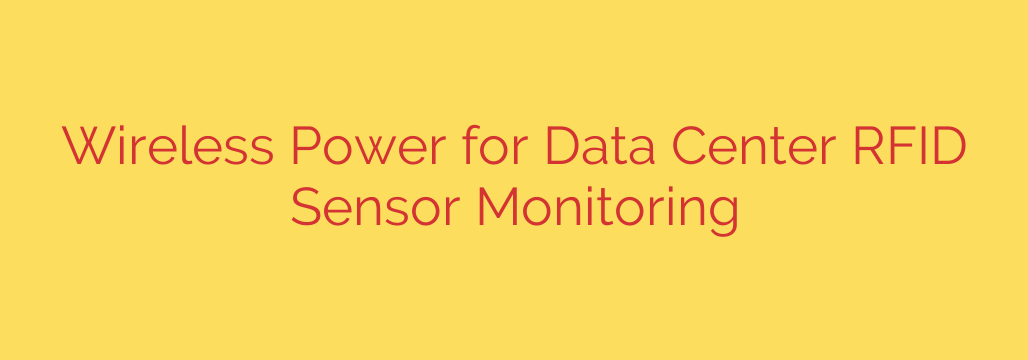
Revolutionizing Data Center Management: The Power of Batteryless RFID Sensors
Data centers are the invisible engines of our digital world, housing the critical infrastructure that powers everything from cloud computing to global finance. Maintaining the precise environmental conditions within these facilities is not just important—it’s essential for ensuring uptime, security, and operational efficiency. For years, managers have faced a difficult choice for monitoring these environments: cumbersome wired sensors or battery-powered ones that create a massive maintenance burden.
Today, a groundbreaking technology is changing the game: wire-free, batteryless sensors powered by radio frequency (RF) energy. This innovative approach leverages the principles of RFID to deliver real-time, granular data without the crippling downsides of traditional methods.
The Old Dilemma: Wires vs. Batteries
Effective data center monitoring requires placing sensors in hundreds, if not thousands, of specific locations—from individual server racks to air handlers. The traditional approaches have always come with significant trade-offs:
- Wired Sensors: While reliable, installing wired sensors is incredibly expensive and disruptive. The cost of running cables, especially in a pre-existing facility, can be prohibitive. It also adds complexity and potential points of failure to an already intricate environment.
- Battery-Powered Sensors: These offer more flexibility but introduce a relentless maintenance cycle. Replacing thousands of batteries on a regular schedule is a logistical nightmare that consumes staff hours and creates hazardous waste. Worse, a single failed battery can create a blind spot in your monitoring, putting mission-critical assets at risk.
A New Paradigm: How Wireless Power Works
Imagine a sensor that has no battery and needs no data cable, yet can provide constant updates on temperature, humidity, or air pressure. This is the reality of wireless power technology, often referred to as energy harvesting.
The system works elegantly and efficiently. A central reader, similar to a standard RFID reader, transmits low-level radio waves throughout the data center. Specialized RFID sensor tags, placed wherever monitoring is needed, capture this ambient RF energy.
An integrated circuit on the tag converts the radio waves into usable electrical power. This harvested energy is all that’s needed for the sensor to wake up, take a measurement, and transmit that data back to the reader. The entire process happens on demand, providing real-time insights without a single battery or wire.
Key Benefits of Batteryless RFID Monitoring
Adopting this technology offers a powerful suite of advantages that directly impact a data center’s bottom line and resilience.
Dramatically Lower Operational Costs
The most immediate benefit is the complete elimination of battery replacement. This eradicates the cost of the batteries themselves, the labor required for replacement, and the expense of hazardous waste disposal. Installation is as simple as placing a tag, slashing the high costs associated with wiring.Granular, Rack-Level Insights
To truly optimize cooling and prevent dangerous hot spots, you need data from the right places. Batteryless tags are small and inexpensive enough to be deployed at the front, middle, and back of every single server rack. This provides a highly detailed thermal map of your facility, allowing you to identify and resolve potential issues before they cause an outage.Unmatched Scalability and Flexibility
Need to monitor a new row of racks or a different environmental variable? With a batteryless system, scaling your monitoring network is effortless. You can add hundreds of new sensor points without worrying about power sources or complex installations, future-proofing your facility for changing needs.Enhanced Uptime and Reliability
By providing continuous, real-time data, these sensors empower a proactive approach to facility management. Instead of reacting to failures, you can predict and prevent them by analyzing trends in temperature and humidity. This leads to greater equipment longevity, improved PUE (Power Usage Effectiveness), and a significant reduction in the risk of costly downtime.
Practical Applications and Actionable Security
The use cases for wireless power sensors go beyond simple temperature checks. They form a comprehensive environmental security net for your entire operation.
- Precision Temperature Monitoring: Ensure ASHRAE compliance and prevent hardware failure by monitoring for hot spots at the server inlet.
- Humidity Control: Protect sensitive electronics from both corrosion (high humidity) and electrostatic discharge (low humidity).
- Air Pressure Differentials: Verify the integrity of your hot-aisle/cold-aisle containment by ensuring air is flowing correctly, which is critical for cooling efficiency.
- Integrated Asset Management: Since the technology is built on RFID, each sensor tag also carries a unique identifier. This means you can simultaneously monitor the environment and track the physical location of valuable assets like servers, switches, and storage arrays.
For any data center manager or IT leader planning an upgrade or a new build, it is crucial to look beyond traditional solutions. When evaluating monitoring systems, ask vendors specifically about their wire-free, batteryless RFID sensor capabilities. Investing in this technology is an investment in operational intelligence, long-term cost savings, and the ultimate reliability of your critical infrastructure.
Source: https://datacenterpost.com/transforming-data-center-monitoring-with-wirelessly-powered-rfid-sensors/








